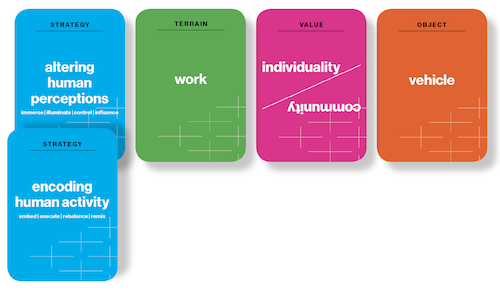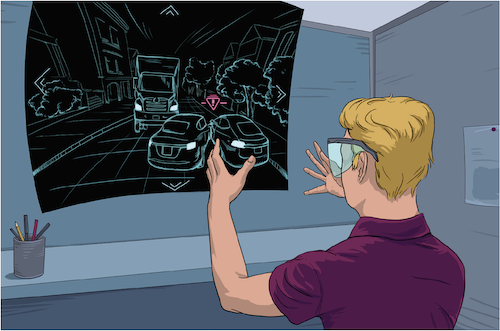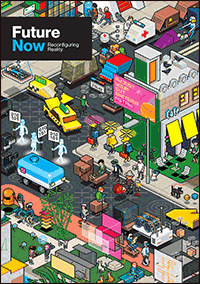Future Now
The IFTF Blog
The Fleet / Car and Rider
[This article is one of a four-part series in Scenes From 2027]
The Fleet
What happens when fleets of autonomous cars battle it out for the same street corner?
As fleets of autonomous cars make their way into messy, crowded city streets, new systems of interaction design emerge to ensure safety and reliability. Embedded algorithms compete and interact with each other, and with on-demand tech support workers, developing strategies and systems that influence everything from tiered pricing to evaluations of human job performance. When autonomous machines are constantly negotiating with humans and other machines, how do they explain themselves in ways that can be understood?

What
The Autonomous Car Fleet consists of independent vehicles largely controlled by decentralized algorithms. Watchdog processes from myriad stakeholders monitor the fleet. When algorithms are unable to respond to a situation, humans are called upon—a designated driver inside an actual vehicle, or a teleoperator. Realworld complexity and interacting with a legacy fleet requires creative decisions that are beyond the capabilities of current algorithms. A remote operator, using an augmented reality interface, can “jump in” and briefly take over. The challenging situations they face undoubtedly make these human operators more prone to accidents and make the whole system more unpredictable, but those individuals can also be creative and bend rules whenever necessary. Uniquely-human attributes are particularly useful to extract passengers from medical or personal emergencies, to escort political figures, or VIPs who can pay a premium for priority service. The human edge in these situations might not be permanent, since the algorithm will learn from human interventions—assessing performance, learning tactics, and building improved algorithms.
So What
By 2027, autonomous vehicles will likely be mainstream in many parts of the world. But complete autonomy will remain elusive;, humans could be interceding for many “last mile” and non-routine situations. Fleet operators and municipalities may monitor the vehicles from the cloud—employing various strategies to optimize portions of the overall vehicle ecosystem. There is no guarantee that their strategies will peacefully co-exist. The stakeholders, including algorithms, passengers, and drivers will constantly maneuver and negotiate for efficiency and economy. The resulting ecosystem will be exceedingly complex and unpredictable—and the shift will require us to rethink everything from how we plan journeys, to how vehicles are bought and sold, to how legal responsibilities are assigned. Other societal systems will need to be rethought—like how massive population evacuations can happen in a world where transportation has transitioned from being a personal vehicle to a service. These shifts will not be limited to vehicles—as partial or total automation comes to other systems in our society, we will see similar dynamics emerge, requiring ongoing renegotiations of accountability, and debates about the values that these new technologies embody.

Car and Rider
Written by IFTF Research Affiliate Scott Minneman for volume three of Future Now,
IFTF's print magazine powered by our Future 50 Partnership.
Behind the "autonomous" fleet
[Official Protest Logged: Unnecessary Human TeleDriver Intervention] [Operational Parameters: Normal; Velocity: 17.3; Heading: 48.1; GPS: 37.756, -122.429]
Goog1639 turned the corner and headed up the block on Liberty Street. The situation hadn’t appeared particularly dire. The autoCar’s adult passenger had glanced up, but no concern manifested in the emotiCam. Yes, a furniture delivery vehicle was stopped mid-block, and with these narrow streets, traffic would be choked down to a single lane. One side effect of the latest traffic routing algorithms was that even the autonomous vehicle fleet used minor residential streets like this one. The whole city crawled with traffic, but the algorithms kept everything moving smoothly. Usually.
[Passenger 1: Female; Age: 37; Emotional State: Within Normal Parameters] [Passenger 2: Juvenile Male; Age: 41 months; Emotional State: Agitated (Unrelated to Incident)]
When Goog1639 turned, nothing seemed awry. Up ahead, however, Tes1582 and Tes6726 had just blocked the remaining lane alongside the furniture truck. Algorithms typically prevented or resolved such incidents (courtesy back-down routines), but these vehicles were both running in Platinum Mode. a higher-priced option that radically reduced autoCar driving civility levels. Although it could shave a few minutes off a trip, it already was proving to be an annoyance.
[Vehicle Anomaly: Wheel; Right Front: Losing Pressure; Damage Mitigation Initiated]
Platinum Mode ran with maximum acceleration, rolling stops, tailgating, and other parameters tuned to complete trips faster. It was all vaguely legal, but it essentially worked by gaming the algorithms in the rest of the fleet (while also intimidating nearby pedestrians, cyclists, and remaining human drivers). Get two Platinum Mode cars in opposition and neither’s algorithm was going to back down.
[Damage Mitigation: Unsuccessful; Right Front Tire Pressure: 0] [Vehicle Parameters: Other Settings Accommodating Run-Flat Mode] [Vehicle Request: Service Required; Status: Urgent]
Goog1639’s legacy algorithms indicated that it should have cleared rapidly, but this Tes autoCar duel hadn’t cleared. Noting the lack of motion, Goog1639’s cloud-based central monitoring assessed whether or not to summon help. Triggering human intervention was expensive, didn’t always work, and ended up in the regulatory log. Still, after a massive five-hour jam in Boston, fleet operators had become cautious. Teleop164, a human operator, was called to extract Goog1639.
[Passenger 1: Emotional State: Acceptable, but Impatience Level Rising] [Passenger 2: Emotional State: Agitated (Unrelated to Incident)]
Using a local drone he’d rented 30 seconds of time on, Teleop164 quickly sized up the situation. Executing a U-turn in the narrow confines of a partially obstructed Liberty Street would require some creative driving—the challenge compounded by compatibility issues with Teleop164’s latest-generation VR headgear. The drone view gave Teleop164 a perspective where he identified an opportunity. Seizing control from Goog1639’s AI, he sharply exited the auto-Car out of the line of stopped cars, accelerated across the opposite lane, popped onto the sidewalk to turn around, and quickly reversed down the street. Certainly not a textbook three-point turn, but it worked. It took 73 seconds, prevented a possible failed journey, and avoided costly idle time. Teleop164 was proud of his extrication—no algorithm would’ve come up with that move. Goog1639’s emotiCam noted mild alarm from both passengers during the maneuver (followed soon after by relief from Passenger 1), but still concluded that it should file a protest about the intervention with central control (Goog1639 also analyzed the intervention, however, to determine if it could be incorporated into its algorithms for self-extraction in future incidents).
[Trip Estimate: Revised; Time Estimate Adjusted: 180 Seconds Late Due to Run-Flat Mode]
Teleop164 flicked his headgear back into AR Mode. Remote driving was a stressful gig, but it paid well, impressed his girlfriend, and was satisfying. Business had fallen off in recent months, though, as more cities restricted human-driven cars, and the automated fleet had fewer incidents where skills like his were needed. To Goog1639, the Teleops’ methods appeared a little crazy.
[Service Request: Approved] [Service Options: Under Evaluation]
Popping the curb, though, had apparently pinched the tire, and it was going flat (the tire pressure monitoring system noted the anomaly). Run-Flat Mode was immediately invoked to prevent further damage, but it limited Goog1639’s speed and cornering abilities. This was a sub-optimal development, and definitely a counter-indication for using that particular method of traffic extraction in future jams. Statistically, Teleops had a bad record—vehicle damage was common, and repairs could be costly and time-consuming. Lienholders knew they were taking risks whenever intervention was invoked, but it paled when compared to hours of downtime from a jam.
[Service Option: ACar187; Previous Visit: 12:38 on 2/16/2026; Aggregate Outcome Rating: 4.93] [Booking Service: Immediate] [Passenger 1: Emotional State: Annoyed and Impatient] [Passenger 2: Emotional State: Highly Agitated (Possibly Related to Incident, Possibly Related to Passenger 1’s Adverse Reaction)]
The rest of Goog1639’s journey was uneventful, but Run-Flat Mode made progress seem glacial. Passenger 1 was annoyed, but they were fairly close to their destination, and she hadn’t opted for a vehicle change. If she had, Goog1639 would have taken a hit in reliability rankings, so Run-Flat Mode had really come to the rescue.
[Service: Sending Vehicle Information; Requesting Repair: Right Front Tire; Additional Services: Evaluating Options] [Arriving at Rider Destination]
Goog1639 signaled (for the few humans on the road; other autoCars, part of the data network, were fully aware of its route), swung to the curb, and allowed the woman and child to exit. It was disappointing to be a little late, but the emotiCam registered more relief than anger in Passenger 1, and little evidence that she would lodge a complaint.
[Passengers Discharged]
Goog1639’s trip to the ACar187 facility was urgent—tires had limited range in Run-Flat Mode, so they needed to be addressed immediately.
[Routing to ACar187 Service Location] [Switching to Transit Mode; Vehicle Comfort Level: Low]
Jenna had pioneered ACar187 before independent autonomous car fleet servicing became a comfortable niche business. Although many thought the monster companies would successfully control all aspects of the fleets, the economies of scale ended up being offset by other factors. Myriad little operators had sprung up, and all of those autonomous cars needed decentralized service—even major brands came to her.
Jenna’s ACar187 was a lightweight operation—she had a stall, a few tools, a fast connection, and, more recently, a bunch of the most common control modules for hot swaps and upgrades, after Over-the-Air software updates were outlawed. A six-day jam in São Paulo, when hackers mostly shut down the fleet (along with “accidents” with people dying in suspicious autonomous car incidents), had convinced everyone that autonomous car software needed to be strictly policed.
[Approaching ACar187 Service Location]
Goog1639 had relayed everything Jenna needed to know to be prepared for the service call. The tire malady could probably be addressed with a soft-microbotic patch introduced through the valve stem. These patches were fantastic, except for their 60-minute chemical battery and brief shelf life—kind of a sacrificial little sea cucumber that would find its way to any leak and sort of die there to thoroughly staunch any leak. Jenna also had a line on a new wheel and tire, if it came to that. She prepped some of the latest software upgrades, although she would need Goog1639 to be present to proceed.
[Arrived at ACar187] [Tire Service Initiated; Fault: Pinch Flat; Visual Inspection Assessment: Repairable]
Goog1639 pulled in, and Jenna leapt into action. After removing the valve stem core, she inserted an inspection bot that located the problem and concluded it was repairable. Jenna sent in a clean-and-prep bot to get the leak site ready. The inspection bot remained inside to help position the microbotic patch. Jenna squeezed that leak-repair bot through the valve stem, and let it start inching its way to the damage site, where it would be properly oriented by the inspection bot. This was going to take a few minutes, so Jenna pitched software upgrades to Goog1639—mostly security patches and performance tweaks.
[Software Upgrades: Evaluating Options] [Software Upgrades: Approved]
It had been a while since Goog1639 was at a full-service facility. A quick analysis indicated it would have nicely improved capabilities, allowing it to charge a premium for some of its journeys. It opted for the full package. Jenna loaded up a new lidar module, a power-management unit, and some expanded processing modes in the primary driving logic module. It wasn’t hard work, mainly unplugging and plugging nondescript plastic boxes, but it had to be done right. Jenna had heard of other techs bricking cars—an incident like that could tank her business.
[Software Update: Lidar Module; Status:Complete and Operational] [Software Update: PMU; Unlocked: Risible; Status: Complete and Operational] [Software Update: Primary Driving Logic; Unlocked: DM; Status: Complete and Operational]
The car was ready for the streets again. End to end, elapsed time was 18 minutes. Goog1639 registered a five-star rating for Jenna and ACar187—other shops would have only addressed the Air Pressure issue and not bothered with upgrades.
[Returning to Service; Offline Time: 17:53] [Accepting Booking; Passenger 1: Male, 27; Destination: Apple Store Union Square; Mode: Diamond]
Goog1639 reset its status as now enabled for Diamond Mode service, fresh competition for those nasty Platinum Mode autoCars. Emotions weren’t part of Goog1639’s programming, but it was totally psyched.
 FUTURE NOW—Reconfiguring Reality
FUTURE NOW—Reconfiguring Reality
This third volume of Future Now, IFTF's print magazine powered by our Future 50 Partnership, is a maker's guide to the Internet of Actions. Use this issue with its companion map and card game to anticipate possibilities, create opportunities, ward off challenges, and begin acting to reconfigure reality today.
About IFTF's Future 50 Partnership
Every successful strategy begins with an insight about the future and every organization needs the capacity to anticipate the future. The Future 50 is a side-by-side relationship with Institute for the Future: a partnership focused on strategic foresight on a ten-year time horizon. With 50 years of futures research in society, technology, health, the economy, and the environment, we have the perspectives, signals, and tools to make sense of the emerging future.
For More Information
For more information on IFTF's Future 50 Partnership and Tech Futures Lab, contact:
Sean Ness | sness@iftf.org | 650.233.9517



